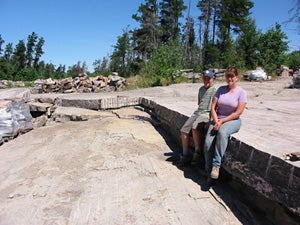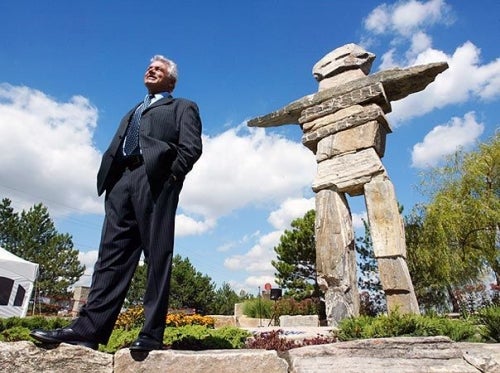Our large piece of gneiss that will span 3 levels when the new earth sciences building has been completed is officially installed! On December 1, it was placed in the foundations of the new "Centre for Environmental and Information Technology" building, where the museum will be located.
After a number of failed attempts, this 9 metre long slab was extracted from Allstone quarry, Bigwood Township, near Sudbury. It was then shipped to Schomberg to have a concrete block formed on one of its ends. It finally arrived in Waterloo and was installed so that the rest of the building can be constructed around it.
What is gneiss?
Gneiss is a foliated rock, of high metamorphic grade, consisting of alternating mineralogically distinct (usually felsic (light coloured) and mafic (dark coloured) layers. The recrystallization process separates the minerals into layers by strong deformation (strain). Viscous flow of the rock occurs under conditions of very high temperature and pressure. These rocks are commonly the result of partial melting of the original rock under conditions of very high metamorphic temperatures.
During regional metamorphism such as occurs in mountain belts during the mountain-building episode (orogeny) there is always intensive deformation. Under the high temperatures and pressures within the core of such belts, the rocks deform, not as rigid, brittle objects, but by flowing in a viscous fashion. The layering and foliation that exists in the gneisses is commonly deformed subsequently. Thus we may observe folds, sometimes of quite complex form. Nice examples are present in the monolith.
The geologic history of our monolith
Its home for the past billion years (more-or-less!) has been with rocks that now are exposed in an outcrop north of the French River in Bigwood Township, south of Sudbury. This is an area that occurs within the Grenville Tectonic Province of the Canadian Precambrian Shield. The Grenville Province comprises the roots of a collisional orogenic (mountain) belt that is exposed along the southeastern margin of the Canadian Shield from the east coast of Georgian Bay as far as the Labrador coast. In reality, the Grenville rocks go much farther than that and have been identified in southern Norway and southwestern Sweden before they dive under younger rocks again. In the other direction, they are known to extend in the subsurface at least as far as the Sierra Madre mountains in Mexico. Some folk even contend that the same fold-belt can be found in Antarctica and possibly even on the southeastern margin of Africa. The ponderous pavane of plate tectonics certainly frees up the imagination!

Two people sitting in the space that the giant piece of gneiss was removed from
The Grenville mountains were formed around a billion years ago when some other wandering continent collided with the eastern flank of the Laurentian Craton, i.e. proto-North America. The latest idea is that this bulldozing bully may have been the western flank of what later became South America! As a consequence of this head butting, the Grenville mountains were thrust up in a series of stages into a mountain range that would have resembled, perhaps even rivaled, the contemporary Alpine/Himalayan chain. This happened between 1.3 billion years ago) and 950 million years ago).
The French River gneisses appear originally to have been part of the margin of the Laurentian craton (continental core) and had been emplaced during an even earlier magmatic/metamorphic event sometime between 1.9 and 1.45 billion years ago. We would have to date our monolith radiometrically to determine when within this rather large range our rock was born. However, its rest was not peaceful for once the Grenville collision occurred it was heated and deformed under the combined pressure of the colliding continent and the weight of perhaps as much as 25 km of superincumbent rocks. It was during this protracted orogenic stage that our gneiss became, gneissic, migmatitic and folded, all more-or-less at the same time.
To human eyes young mountain ranges appear as prominent upward thrusting elements of topography, but like an iceberg their greatest mass is really below the surface and extends downward as a great root into the upper mantle and, to use another analogy, when the superstructure of the range is reduced by weathering, erosion and transport of sediment away from the range, the whole belt, root and all, rise buoyantly, like a ship being emptied of its cargo. Thus, over perhaps hundreds of millions of year, the Grenville rocks rose inexorably upward in response to surface unloading and the French River gneisses came closer and closer to the surface, cooling all the while. It would appear that they were not far from their present crustal level as the Precambrian Eon turned into the Phanerozoic and the pages on the calendars flipped over to the Cambrian period. The final event, perhaps, was the passage overhead of the great Pleistocene ice-sheets, which scraped away the final few centimetres off the surface and the gneiss finally saw the light of day.
So, should you ever pass through the atrium of Earth Sciences’ new home, pause and cast your eyes at the oldest member of the department, standing here proudly. Tip your hat to it and say, "What a nice gneiss - and have a good day!
-Ted Appleyard
I was created ...
over 1,000 million years ago.
A movement of elements and compounds; under unimaginable forces of heat and pressure.
Deep in the Earth.
Above me, mountains, snow-capped, stretched to the skies. Until they were scattered, to the winds and the seas.
Seas wherein dwelled strange animals,
that flourished and vanished, in cycles repeated, time after time.
For aeons of aeons
I remained hidden. And, finally, another mountain
... of ice ...
exposed me to the stars.
A cloak of earth shrouded me for 10,000 years.
Until again I was revealed, torn from my resting place, and transported.
Now, I stand in an unnatural place, for all to see.
A pillar of time, one quarter as old as the Earth.
A monument.
To the forces that shaped our world. And I wait, in my turn, To return to my origins, In the cycle of life.
Alan Morgan
Little Joe

"Little Joe", the worlds largest inuksuk comes from the same quarry as our gneiss monolith! This enormous inuksuk is 11.38 metres tall and weighs 90 tons.
He stands on the east side of Highway 27, just south of Schomberg. "Little Joe" is made up of 11 pieces of granitic gneiss which all came from the Grenville Mountains on the Canadian Shield, near Sudbury, from the same quarry as our monolith. He was made by Joe Melo, president of Allstone Quarry.